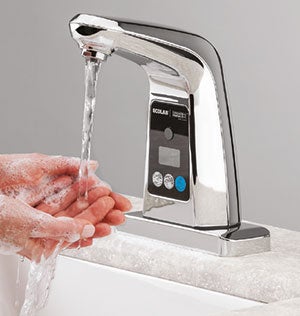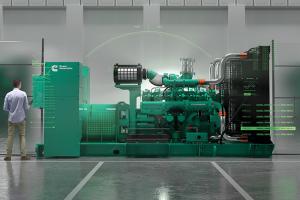Hospital plumbing system advances
Antimicrobial surface treatments, new designs for sensor faucets and sophisticated monitoring technologies that promote water conservation — these are all features of new plumbing products designed to improve efficiency in health care facilities. Other innovations include enhanced touchless faucets and sloping sink profiles that minimize splashing during hand washing, thus reducing the possibility of slip-and-fall accidents.
Among the challenges faced by manufacturers is the fact that hospitals house public spaces, private rooms, labs and nurse stations, which require different types of plumbing products. Challenges include meeting sanitary and sustainability guidelines, as well as being able to effectively source the multiple types of faucets, shower heads and flush valves needed to support the everyday function of a hospital.
What's more, growing numbers of plumbing products are being installed in small, off-site facilities such as specialty clinics, and there are differences in product requirements between these sites and large hospitals.
You may also like |
| Plumbing system design and maintenance |
| Complying with ASHRAE’s legionella requirements |
| Advances in plumbing systems offset costs |
|
|
“Having a full lineup is a challenge because codes differ between regions and municipalities, so each tweak can require us to make significant changes to products for a particular region,” says Rob Zimmerman, director of sustainability marketing, Kohler Co., Kohler, Wis. “Concern about infectious diseases continues to grow. Thus, the demand for antimicrobial and sensor-activated products is gaining momentum,”
Product flow
As manufacturers strive to overcome these challenges, they have developed a wide range of plumbing products with the health care market in mind:
Faucets. Zurn Industries LLC, Milwaukee, recently introduced the Aqua-FIT Z6950 sensor faucet. It offers adjustable settings such as time-out, line purge, sensor range and metering mode as well as multiple power options. The two-minute line purge and field-adjustable setting prevent water from stagnating in the supply line. This feature was added in response to requests from hospital facilities managers, the company reports.
Sensor-operated faucets from Moen Commercial, North Olmsted, Ohio, feature a sentinel flow option that eliminates stagnant water in supply lines every 24 hours after the last use. They also feature an adjustable metering flow time from 10 seconds to three minutes for health care environments where code requires timed hand washing.
“Hands-free faucets improve sanitation and water savings,” says Lisa Shimko, associate product manager, Moen Commercial. “Given the high usage in hospitals and the need for long-lasting batteries, Moen recently introduced M-Power sensor-operated, below-deck lavatory faucets. They use standard AA batteries with no replacement required for up to eight years.”
T&S Brass, Travelers Rest, S.C., has introduced sensor faucets with above-deck electronics that improve hygiene in health care settings. A key feature automatically flushes the line if the faucet has gone unused for a set period of time. In low-usage applications, this can reduce the buildup of bacterial growth. Also, the electronics are housed above deck, which decreases the time it takes to service the faucet and eliminates the need to get under the counter to perform basic maintenance such as changing batteries.
“We see a trend toward more sensor faucets and decreasing flow rates — trends that support water-conservation efforts,” says David Scelsi, marketing product manager, T&S Brass. The company also offers a hydro-generator option for sensor faucets, which uses water flow to power the device, rather than batteries or AC power.
The EFS hand wash system from Chicago Faucet Co., Des Plaines, Ill., eliminates the need for surface contact while reducing water consumption, the company reports. The sensor-operated system delivers a three-step sequence: water and soap; timed scrub; and timed rinse. This sequence is based on Centers for Disease Control and Prevention recommendations for proper hand-washing protocol. Lighted icons on the spout guide users through this sequence. In addition, EFS features low-soap and low-battery indicators.
Sinks and drains. Just Manufacturing Co., Franklin Park, Ill., offers CuVerro antimicrobial, copper-nickel hand-wash stations for patient rooms, nurse stations, emergency rooms, intensive care units and other areas of the hospital. Touch surfaces made from CuVerro antimicrobial copper continuously reduce bioburden, creating a more hygienic environment and reducing the risk of spreading infection, according to Bruce Keclik, product manager.
The company also has developed the Integra Drain system, which adds to the hygienic element of the sink. By eliminating crevices in the sink bottom and the drain body, where standing water may occur, it reduces opportunities for bacterial growth. Without the standing water, there is no breeding area for pathogens and biofilms.
Whitehall Manufacturing Inc., City of Industry, Calif., designs standard plumbing products so that a single fixture or fixture trim can meet complex demands such as ligature resistance, infection prevention and water conservation. For example, the company has introduced a contoured sink with offset drain that prevents splashing and addresses infection prevention needs. The sink’s design also allows for easy retrofit, which helps to meet Americans with Disabilities Act and water conservation requirements, according to Kristin Kahle, vice president.
American Standard Brands and GROHE, Piscataway, N.J., offer sloping sinks that minimize splashing during hand washing as well as high-arching gooseneck faucets that direct water flow to the sink’s slanted back wall. Touchless faucets, plain spout ends and laminar-flow design contribute to infection control, according to Tony D’Amato, senior product manager for commercial fittings.
“Our ICS Scrub Sink system is designed to prevent splashing, which has been shown to be a major cause of spreading germs in patient rooms. Special surface finishes, such as the American Standard EverClean permanent finish, inhibit the growth of stain- and odor-causing bacteria, mold and mildew on the sink’s surface,” D’Amato says.
“We see further expansion of touchless faucets that are designed specifically for health care facilities,” he adds. “Removing aerators and locating the flow restrictor in the spout shank provides a clean laminar flow that eliminates water and air from mixing. The plain spout end also eliminates crevices that can collect lime and debris, and harbor bacteria.”
Toilets. Kohler Co. has introduced an antimicrobial coating that provides an added level of protection to its line of commercial toilets, according to Zimmerman. In addition, the toilets are capable of flushing with only one gallon of water, making them ideal for Leadership in Energy and Environmental Design buildings or other areas where water-efficiency is a focus.
AcornVac Inc., Chino, Calif., offers a vacuum flush toilet that eliminates the aerosol and splash typically created when a toilet is flushed. This feature has generated interest within the medical community because it enhances infection control efforts, the company reports. In addition, the toilet provides a highly efficient flush that uses less than a half gallon of water.
Recent research has identified toilets as contributors to the spread of infection within hospitals, due to the creation of a bioaerosol plume that occurs during flushing, according to Laura Marshall, vice president, AcornVac Inc. Vacuum toilets, she says, offer a solution to this problem. “By eliminating the bioaerosol plume, they reduce the introduction and spread of pathogens in the bathroom and migration into patient care areas. Vacuum plumbing also solves design and construction challenges; it allows for more effective use of space, reduced construction timelines and lowers renovation costs.”
Sam Karge, vice president of sales and marketing, Zurn Industries LLC, has seen increased use of floor-mounted toilets in hospitals. “While wall-mounted bowls are still the most commonly used commercial toilet due to ease of cleaning, some health care design engineers are opting to utilize floor-mounted toilets due to increasing patient weight,” he says. Zurn Industries offers a standard wall bowl carrier with a 500-pound load rating as well as 750- and even 1,000-pound carriers, which accommodate increased patient weight and offer easier cleanability.
Other innovations. Pressalit Care Inc. North America, East Dennis, Mass., offers height-adjustable sanitary tables for changing or showering disabled adults. Water supply and disposal connections are integrated into the units for convenience, and a slightly curved surface helps to drain water toward waste outlets. Weight capacity allows handling individuals up to 440 pounds.
The design allows for easy transfer between wheelchair and table by allowing the caregiver to raise or lower the table to the same level as the wheelchair. Once the patient is transferred to the table, the caregiver can raise it to optimal working height to change or shower the recumbent patient. When not in use, the table can be folded against the wall to save space.
The Terreon Deep Well Lavatory from Bradley Corp., Menomonee Falls, Wis., is designed for general health care, sanitary and hand-washing applications. The molded, single-piece design features extra height on the side splashes and a deep-well basin that minimizes splashing and helps to contain water and other fluids, which helps to address infection control issues. In addition, the basin’s internal ledges are pitched toward the bowl’s center to minimize pooling and facilitate quick drainage.
The lavatory system is made of vandal-resistant Terreon solid-surface material that is easy to clean and maintain, according to Kris Alderson, senior marketing manager. Terreon is nonporous with no cracks or crevices because it’s molded as one piece, so it does not harbor bacteria. “Touchless technology used with sinks, soap dispensers and hand dryers will continue to be a priority because this high-demand and user-friendly technology helps to cut down on germ-laden surfaces,” Alderson notes.
Below ground, Charlotte (N.C.) Pipe and Foundry Co. offers ChemDrain CPVC pipe and fittings systems for chemical waste drainage. Resistant to acids, salts and a wide range of organic media, the systems reportedly are safe, durable and easy to install. “Also, while not new, cast-iron soil pipe systems remain a popular choice for hospitals due to the fact that they are not combustible, can tolerate elevated temperatures, and have structural strength and durability,” says Bill Morris, vice president, technical services and product development.
Looking ahead
Moving forward, Kahle sees growing use of advanced plumbing systems in smaller, rural treatment centers. Despite the smaller size of these facilities, challenges can arise in the construction or renovation that more residentially focused contractors may not be equipped to handle.
Another trend manufacturers see is that technology will play an even greater role, whether it is a smart faucet that can alert management to performance issues or a fully connected smart restroom where all devices communicate with each other.
Neal Lorenzi is a freelance writer based in Mundelein, Ill.
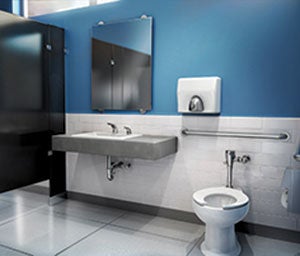
WEAR-RESISTANT
M-Power sensor-operated products — faucets, soap dispensers and flush valves — provide heavy-use facilities with hygienic solutions to maintain sanitary environments and reduce maintenance. Moen Commercial
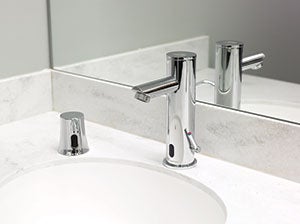
SAVING WATER
Sensor faucets offer improved hygiene and increase conservation for health care facilities. T&S Brass
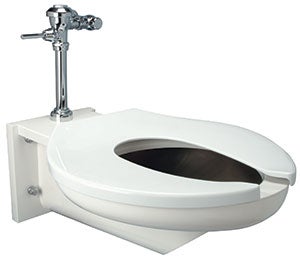
SEAT SUPPORT
Zurn has developed specialty bariatric toilets such as the Z5691 with matching Z1201-N-XB high-performance carrier capable of supporting up to 1,000 pounds. Zurn Industries LLC
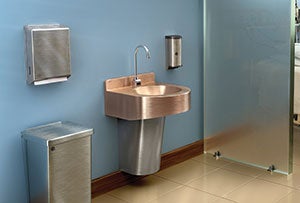
IN ITS ELEMENT
CuVerro antimicrobial, copper-nickel hand-wash stations reduce the risk of spreading infections. Just Manufacturing Co.
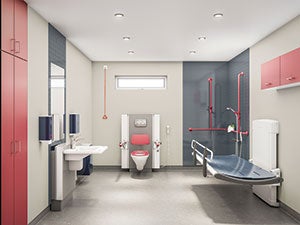
UPLIFTING
Changing table 3000 is a height-adjustable, sanitary table used for changing or showering disabled adults. Pressalit Care Inc. North America
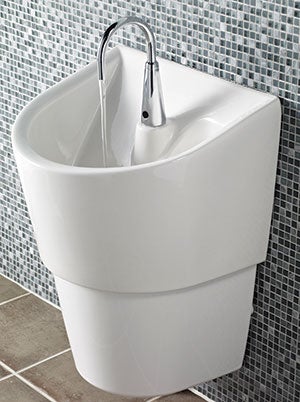
HANDS-FREE
The touchless faucet in the ICS Scrub Sink system features a laminar-flow device in the spout base designed to prevent air from being drawn into the water stream. American Standard Brands and GROHE


